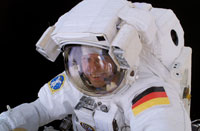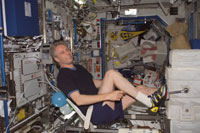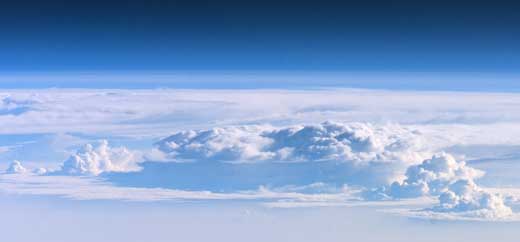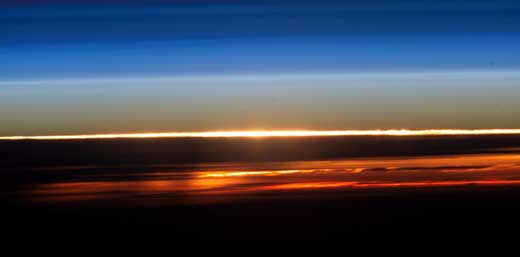Down to Earth: interview with Thomas Reiter Understand article
Shortly before Christmas 2006, German ESA astronaut Thomas Reiter returned from the International Space Station. A month later, Barbara Warmbein asked him about his trip, the experiments he did – and how to become an astronaut.

spacewalk on 3 August 2006
Image courtesy of NASA
Thomas Reiter, German astronaut for the European Space Agency (ESA)w1, is a true veteran of space flight. The 49-year-old father of two boys has spent more hours in space than any other ESA astronaut – almost a year in total, with 179 days on the Russian MIR space station in 1995 and 171 days on the International Space Station (ISS) in 2006. A few days before Christmas, he returned to Earth, having successfully completed a six-hour spacewalk (or extravehicular activity), collecting data for many European experiments on board the ISS, and helping to prepare the station for the arrival of the European module Columbus, due for launch later this year. I spoke to him by telephone at the European Astronaut Centre in Cologne, Germany.
How long did it take you to recover from your long trip into space?
The first severe effects were still perceivable the morning after landing, but then recovery progressed very nicely. Right now, four weeks after landing, I don’t feel anything. So within three to four weeks the effects are almost over.

Image courtesy of NASA
What kind of effects did you feel?
There are basically three systems in the body which are affected: the vestibular (balance) system, which shows the most pronounced effect; the orthostatic system, which controls blood pressure and becomes apparent after landing, when you stand upright for a long time and get dizzy easily; and the muscles, which need to re-adapt to gravity. Of course I did a lot of physical exercise in orbit. This helps a lot in accelerating the recovery process. You need to keep your muscles trained while weightless, otherwise they would disappear. But in the first hours after landing, the effects are pretty pronounced.
What do astronauts do when they are on Earth? What are you doing at the moment, apart from giving interviews?
At the moment, the most important task is to prepare all the technical debriefings for the scientists, operations people and management.
Does that mean giving them results of the experiments?
Not only results. I don’t work on results of scientific experiments because that is done by the scientists themselves. But they like to know under what conditions the experiments were executed. And of course there are a lot of technical questions from our systems and operations people, for example about how they can improve the scheduling to make work on the ISS as efficient as possible – to get as much time as possible for scientific work. These kinds of debriefings are done with every agency. I started that in Houston with NASAw2, now this whole process is taking place here at ESA, and in two weeks I will have the debriefings with our Russian partnersw3.
Did you find anything specific that could be improved?
Of course, there is always something to be done. Our intention was to prepare the operations team for the arrival of the European experiment module Columbus and especially the immediate start of an operation to make full use of Columbus. Based on the last six months that I have been on the ISS, I think we can improve a few things, squeezing a few hours in here and there by streamlining the scheduling process. It is interesting to look at these multitudes of systems that are necessary to make a space station. These include life-support systems, altitude controls, thermal-control systems and so forth. And the experience we have gathered can be used to improve these for future space exploration, in which ESA certainly will take part… going back to the Moon, or then further in the future, going to Mars.
What did you find most impressive during your latest mission?
The most exciting moments are certainly the launch and doing an extravehicular activity.
Isn’t that scary?
It’s not scary, no. But it’s really very, very exciting and everyone who has the chance to be up there looks forward to leaving the station for a few hours at least. There are interesting moments inside as well, catching beautiful views of the Earth or of the starry sky. And there’s the re-entry. Those are the main highlights from a personal, emotional point of view.
But the work is of course the most important thing. Doing all these great experiments, and working at the frontier of all these research projects, is really very exciting. Being on board a space station itself is already something very special. It takes a lot of systems to keep the ISS running, and, even with three people, we have to work hard to maintain these systems so that the station is a place where people can live. But with each additional crew member, the relationship between maintaining the station and producing scientific results will shift much more towards the scientific work.
Which specific experiments spring to mind?
In general, I was performing experiments in the areas of life science, biology, physics and astrophysics. We also had some educational projects, which was interesting because I remember very well when I was a school-child and followed all these space-flight activities.
We had a biological experiment on the growth of plants, to help us understand the processes that happen at the molecular level. The objective is not only to grow plants in weightlessness, but to enhance agricultural output by analysing how plants grow and by improving these processes and making them resistant to particular conditions.
We also had a physics experiment called ‘Plasma Crystal’, which has a huge range of possible applications. At the moment it is still at an experimental stage, with scientists trying to understand how dynamics are affected by weightlessness. There could be applications in a lot of areas, like the production of semi-conductors or building fusion power plants, so this is a very interesting field.
For me as an engineer, it’s interesting to see that even today there are a lot of processes in our body that are not very well understood. We had experiments on our immune system: how it or certain functions of it work. Another area of study was the cardiovascular or vestibular system. So I worked on a really wide variety of activities.

Image courtesy of ESA/Thomas Reiter
You said you also had educational experiments. Can you describe these?
We had an experiment called the ‘Oil Emulsion Experiment’. It was a plastic tube containing water and oil; the oil was coloured red, and of course the water was colourless. You can observe how these two liquids – which do not mix with each other – behave in weightlessness. Here on Earth, the water is at the bottom of the tube and the oil, which has a lower density, is on top. In weightlessness, the oil forms bubbles in the water. The experiment consisted of shaking the tube to try to make an emulsion and then observing how the oil behaves over time. All this was filmed. A lot of school students all over Germany performed the experiment more or less at the same time. They made hypotheses about how the water and the oil would behave and then they watched the video from the ISS. They could then test their hypotheses.
Together with my university, University Neubiberg, we carried out some small experiments showing the stability of rotational motions. For this purpose I had a little aluminium cube with me. It had different moments of inertia, and I rotated this cube around the three different axes. All of this was filmed. You can clearly see that if you rotate this cube around two of its axes, the rotation is stable, but around the third axis the rotation is instable. That experiment was intended for school students in grade 10 (ages 15-16) and above, and for first-year university students.
I think it’s interesting for pupils and students to see these practical applications of weightlessness, which would be very hard to demonstrate here on Earth.
How did you prepare for your stay in the ISS? What did you do to prepare for weightlessness and for the cramped conditions there?
The training takes a lot of time. For me, the immediate preparation for the mission took almost two years. On top of that there’s the initial preparation or basic training that lasts at least another year or a year and a half. You have to learn all the different systems that keep you alive and that you depend on once you are in orbit. You also have to prepare for all the scientific work you are going to do up in space.
You don’t do a lot of preparation for weightlessness. There are few occasions, like parabolic flights, just to experience this feeling for a few seconds, but it’s not really preparation in the real sense, it’s more a familiarisation. For extravehicular activities, however, there is quite a lot of preparation. We use big pools for this purpose. NASA has a huge pool in Houston, where you prepare for extravehicular activities. Usually for each hour you spend in space you have to spend six hours in the pool.
You have two sons. How do they cope with their father being an astronaut? What kinds of questions do they ask you?
You know, just by being with them, they already have a lot of information. It is very rare that they have an additional question. Whenever I’m home, which unfortunately doesn’t happen very often, I talk about the training and about what I did. And when I am in training and away from the family, I usually try to call at least once a day and then I tell them, “I was in the pool today to prepare for my extravehicular activity.” My younger son, who is nine years old now, occasionally has some additional questions, like why a rocket only has three stages.
What made you want to become an astronaut?
That was a dream I had as a child. I followed all the space activities when I was six, seven, eight years old. When I was 11, I watched the first Moon landing. Even then, I dreamed of becoming an astronaut. At the time, getting into this profession was not very likely in Europe, but I was lucky. When there was a selection process – in 1986, I think – I was just the right age and had the right prerequisites. I didn’t think twice about whether I should take part. And it worked out!
You are an engineer and you are also a pilot. Would you say that these are classical qualifications?
To a certain extent, yes. Quite a lot of the Russian cosmonauts and the astronauts on the NASA flights have a similar background. But it’s not the only combination. In all agencies, in ESA, in NASA and also in the Russian space agency, you also find engineers or scientists who do not have a flying background. I think, talking now for the European Astronaut Corps (ESA astronauts who are currently considered active), that the mix of different professions is crucial. We have a very nice mix: some scientists, doctors, engineers, and even teachers. Some are pilots like myself.
Can you give a general recommendation to children who want to become astronauts?
If they are thinking of becoming an astronaut, they should consider studying physics, engineering, biology or something like that. And they should get some experience in a profession: no astronaut is selected directly from university.

Image courtesy of NASA
Web References
- w1 – European Space Agency website
- w2 – The website of NASA, the US National Aeronautics and Space Administration
- w3 – The website of the Russian Federal Space Agency
Resources
- More information about Thomas Reiter’s Astrolab mission, including fact-sheets on all the experiments he performed, is available here.
- ESA have also produced many educational materials relating to the International Space Station (ISS):
- A printed ISS education kit for both primary- and secondary-school teachers is available in all 12 ESA languages. The kits are based on all the fascinating activities involved in building, working and living on board the ISS, and provide background information and exercises for classroom teaching. They are available to all school-teachers in ESA member states and can be ordered free online: www.esa.int/spaceflight/education
- An interactive version of the ISS education kit is available here.
- A series of ISS DVD lessons cover topics relating to European school curricula. The second in the series, entitled Body Space, explores the effects of weightlessness on the human body, for example on the vestibular (balance) system. The DVDs can be ordered free by teachers: www.esa.int/spaceflight/education
- Robotics, the fourth ISS DVD, will be released at the end of 2007. It includes an interview with Thomas Reiter and features many of the experiments he performed during his recent mission.
- By the end of 2007, a web lesson about the experiment on stability of rotational motions will be available on the ESA website.
- Further details and education materials can be found on the:
Institutions
Review
This article provides an interesting glimpse into the life of an astronaut. It gives information about some of the experiments and work carried out during a tour of the International Space Station, as well as describing how the astronaut felt during a mission.
The article has a number of uses: as an information source for school projects, an interesting article for a comprehension exercise, or even as a source for careers advice.
Mark Robertson, UK





